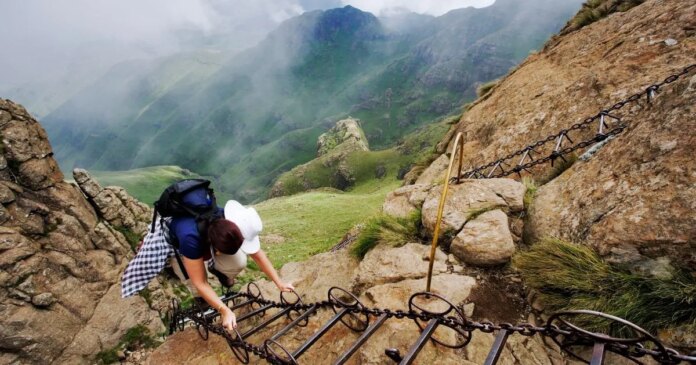Planning a trip to South Africa? Read on for practical information — basic costs, the best time to visit, how to get around, and how to stay safe — as well as the best things to see and do throughout the country
In a typical year, South Africa welcomes a staggering 15 million visitors, and it’s easy to see why. It’s a country of lively cities, incredibly varied natural landscapes, magnificent biodiversity, and a solemn, fascinating history. If you’ve got South Africa on your bucket list (and if you haven’t, you might well do after reading this!), we’re here to tell you what you need to know before going by way of practical information, and about the best places to see. This is Kiwi.com’s travel guide to South Africa.
South Africa: basic average costs
Local currency: South African rand; €1 = R19
Coffee: €1.90
0.5l local beer: €1.80
Lunch: €8
Dinner in a mid-range restaurant: €16
One-way local public transport ticket: €1.40
Hostel for one night: €20
3-star hotel for one night: €52
The best time to visit South Africa
Overall, South Africa is a year-round destination, but the best time of year for your trip depends on what you want out of it. Summer, from December to February, is when the country sees the most tourists — the weather is hot (temperatures reach over 30°C) and rainfall levels are low. Naturally, people flock to the beach, and this is also when flight and accommodation prices are higher.
The shoulder seasons of spring (from September to November) and fall (from March to May) are great times to visit, as the weather is still warmer than you’d expect of the same seasons in Europe, for example. But if you want to go beyond the cities to see the wildlife — as lots of visitors to South Africa do — the best time to go is winter, from June to August. This is when animals congregate around water sources in the national parks, and when whales are most active on the coast.
Getting around South Africa
There are several ways to get around South Africa once you arrive. Pick the means that’ll best suit you and your trip.
By air
Taking domestic flights is the best way to get between cities, if you’re mainly interested in exploring urban South Africa. The country is roughly twice the size of the state of Texas by area (read: big), so flying will save you a lot of time. Flights between the likes of Cape Town, Johannesburg, Durban and Bloemfontein are regular and affordable.
By train
Train travel isn’t big in South Africa, but Shosholoza Meyl still operates long-distance rail journeys between the cities at affordable prices. This is a nice, relaxing way to see the country’s scenery if you have more time on your hands.
By car
When planning to venture into the wilderness, if you can, it’s worth renting a car. This option is even more ideal (and safer) if you’re traveling in a pair or a group, as you can share the driving on long journeys. Having your own wheels gives you the freedom to go where you want when you want, and roads in the most popular national parks such as Kruger and Addo Elephant are well-maintained, so you wouldn’t even necessarily need a 4×4. As you should before driving in any new country, just be sure to read up a bit on the local road etiquette beforehand.
By bus
Bazbus is a renowned tour bus company catering to tourists, operating between Cape Town and Port Elizabeth, making 14 stops along the south coast. They also organize trips from Cape Town to the Cape Peninsula, Kruger National Park, and a local game lodge for a condensed safari experience.
If you want to head elsewhere in the country, and for cheap at that, the most popular intercity bus companies are Intercape and Greyhound.
By taxi
A heads-up: the word ‘taxi’ in South Africa commonly refers to privately-owned local minibuses that don’t go according to a particular schedule, often take more passengers than is safe, don’t have much room for luggage, and are driven erratically. If you need to use a taxi in a South African city, it’s best to stick to Uber.
Staying safe in South Africa
While most people who visit South Africa don’t encounter any problems, it’s worth being aware that the crime rate in the country is significantly higher than it is in Europe. Here are some pointers to ensure you stay safe on your trip.
- Know where not to go. Make yourself streetwise by talking to your hostel or hotel staff, tour guide, or other locals about which areas are good to go to, and which are best avoided.
- Avoid going out after dark. If you need to go out at night, hail an Uber.
- Try not to look too much like a tourist; don’t flash any of your expensive possessions.
- Be extra vigilant in crowded areas. Don’t put anything valuable in any of your pockets that others around you could easily reach into, and be aware of how you can remove yourself from the crowd quickly if needed.
- If a stranger approaches you to offer something, politely refuse and walk away.
- If you’re driving, keep the car doors locked and the windows closed. (This is also applicable when driving through a safari park.) Don’t pick up any hitchhikers or anyone who appears to have broken down, and don’t leave anything that could be considered valuable on display in your car.
- Only use ATMs that are located inside banks or businesses.
- Don’t drink tap water outside of major cities.
It’s a good idea not to travel solo in South Africa, but our article on solo-travel safety tips is still worth checking out for more precautions to take when you’re on your adventures. Wherever you are in the world, it’s important to stay savvy.
The best things to see and do in South Africa
Now we’ve got the practical stuff out of the way, read on to find out what’s worth seeing and doing in South Africa. These options will bulk out your itinerary and leave you with some incredible memories.
Cape Town
Cape Town, one of South Africa’s two capitals, is where you’re likely to arrive when you come to the country. It’s a place definitely worth exploring for its natural beauty, diverse culture, and rich history.
First off, if you could only choose one thing to do in Cape Town, go up Table Mountain to get the best panoramic view of the city, the ocean, and the surrounding peaks. Most visitors get there by cable car, but if you have the time (and the stamina), it’s also a wonderful hike through the eponymous National Park. You also get amazing oceanic views down at the Cape of Good Hope, a rocky headland and nature reserve a little way south of the city, where it’s a bit more peaceful.
Meanwhile, from the northern coast of Cape Town, take a ferry to Robben Island. Fortified and used as a prison right up until 1996, it’s known for being the place where Nelson Mandela was incarcerated the longest. Nowadays, the island is home to a museum of South Africa’s history; in particular, its struggle for racial equality. Come back to the mainland and you’ll dock at the Victoria & Alfred Waterfront, a popular shopping and dining spot, and the location of two museums: the Cape Town Diamond Museum, and the Zeitz Museum of Contemporary Art Africa. Make it a jam-packed day of culture and history.
If you want more museums, you don’t have to venture far into the city center to find plenty of interesting ones. To name a few, there’s the District Six Museum which commemorates people who were displaced during apartheid, the Iziko South African National Gallery, and the Museum of South African Hip Hop. And although it’s on the other side of the city in the Khayelitsha township, it’s well worth making the journey to see the rather unique 18 Gangster Museum, with its exhibits on the causes and ramifications of gang life.
Make sure you also see the Bo-Kaap, the oldest surviving residential neighborhood in Cape Town, with its distinguishing colorful houses and cobblestone streets. It’s an inherently multicultural pocket of the city center, historically home to the Cape Malay ethnic minority who practice Islam. As such, wandering around the Bo-Kaap means stumbling upon some of the first mosques erected in the entire country, the Iziko Bo-Kaap Museum of local Islamic culture, and Cape Malay cuisine — a delicious Dutch-Middle-Eastern flavor fusion.
Cape Winelands
Branch out of Cape Town to the northeast and you’ll find yourself in the Cape Winelands (you’ll never guess what this place is all about!). The area’s Mediterranean climate makes conditions ideal for grapes to grow, and this is precisely where most of South Africa’s wine — some of the best in the world — is made. The university town of Stellenbosch is easy to get to, and coupled with the fact that it’s surrounded by lush vineyards lining rolling hills, it’s not too shabby a base for a wine-tasting stay.
National parks
Lots of people who visit South Africa do so for the nature; the flora and fauna, the mountains, the sprawling savannahs, and the gorgeous coastline. There are some 20 national parks to choose from in the country that collectively offer all this and more. We’ll tell you about a handful of the best ones.
We’ve got to begin with Kruger National Park — the oldest, biggest, and most visited in South Africa. It’s in the northeast corner along the border with Mozambique, far away from Cape Town, but the journey’s a small price to pay for the hundreds of different plant and animal species there are to see. Kruger is the place where you have the biggest chance of catching the Big Five game animals: lion, elephant, leopard, rhinoceros and buffalo, so this is really where you want to be for that quintessential safari experience.
You also have a shot at catching the Big Five at Addo Elephant National Park in the middle of the south coast. Temperatures tend to be fresher down here, the landscape greener and grassier, and the best thing about this option: the opportunity to see penguins, whales, and even the great white shark.
Garden Route National Park is in the same area of South Africa as Addo Elephant, and the climate is very similar, as such. It’s regarded as being one of the very most beautiful parts of the country, with its hills, forests, lakes, beaches and lagoons. Most people drive its over-300-kilometer breadth in the span of several days, stopping in the quaint seaside towns along the way.
Drakensberg and Durban
If you’re up for an adrenaline-pumping adventure, the Drakensberg mountains are the best place to be in South Africa for hardcore hikes, rock climbing, abseiling and paragliding. This vast mountain range is in the east of the country, running along the border with Lesotho, meaning that it’d be best to combine your trip here with a stay in Durban, which sits on the east coast.
Durban is South Africa’s third largest city. It’s a vibrant, subtropical place known for its Indian cultural influence, and you’ll find there are plenty of fun things to do if you come for a couple of days. uShaka Marine World, for example, houses the biggest aquarium in Africa, as well as a theme park, an outdoor shopping mall, and several restaurants. Mini Town is a large-scale model town, built to a scale of 1:24 with some copies of the architecture in Durban itself. The massive Suncoast Casino isn’t just for gamblers — it’s also an extensive entertainment complex, with movie theaters, concert venues and eateries. Take a traditional rickshaw ride (who doesn’t want to be transported in a curious carriage by a man wearing flashy hand-sewn robes and elaborate headgear?). And to wind down after all this stimulation, take yourself to the Botanic Gardens, or go for a simple stroll along the sandy beach.
Johannesburg
Last but certainly not least, on the best places to go in South Africa, we couldn’t not mention the other capital city, Johannesburg. Like Cape Town, it’s a city steeped in interesting history, much of it recent and poignant. It’s a destination that’s much better taken in, listened to, rather than one that requires active participation. Let us demonstrate what we mean.
The Apartheid Museum is probably the most important thing to do in Johannesburg, for the most solid understanding of the rise and fall of one of the most oppressive systems ever to exist in a modern society. The city is also home to the Nelson Mandela Foundation headquarters, which holds exhibitions on contemporary social issues as well as on the life of the revolutionary figure himself. Constitution Hill is another such pick laden with a difficult past — a precinct originally built as a fort for protection against British invasion, it was turned into a prison in the early 20th century primarily to house political dissidents. Today it’s a museum and the location of the Constitutional Court of South Africa.
Soweto — essentially a city within the city — is the most populous township in South Africa, and was the national epicenter of the struggle against apartheid. It’s a real eye-opener both to how South African society worked then, and how the effects of the system are still very prominent today. Soweto can be a bit of a difficult and daunting place to navigate as a visitor, so we highly recommend going on a guided tour so you get to see all the main places of interest safely.
Finally, to round your trip off with something lighter on the soul, check out the neighborhood of Maboneng, one of the most renowned creative districts in the world. Maboneng consists of markets, small businesses, bars, venues, street art and indoor artistic hubs, and at the heart of it all, the common principles of togetherness and “friendly vibes” in what is still a pretty racially-segregated Johannesburg. Here’s a special tip: find the Poolside bar hidden in the Museum of African Design (MOAD) building on Albrecht Street. It’s the last place you’d expect to find a little oasis — in the heart of the city — a quirky, yet modest gem of a place to cool down with a burger and a cocktail.
Did you like this article? For more travel tips, visit Kiwi.com Stories.























